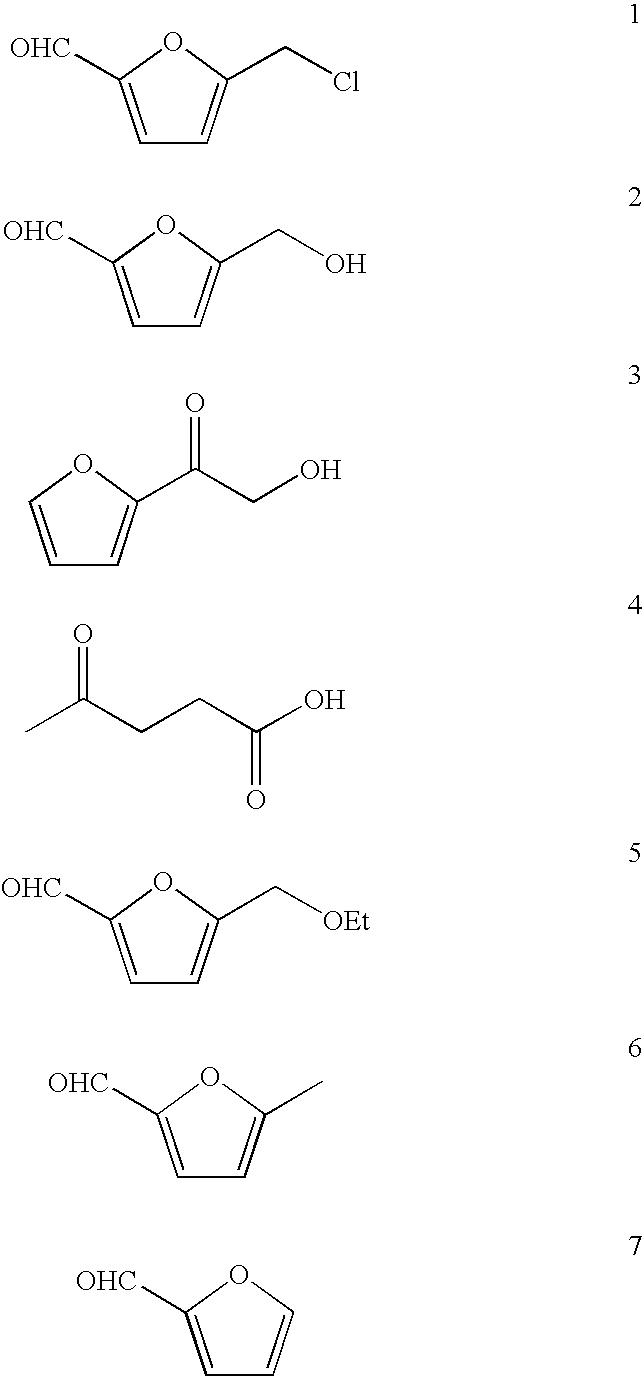High-yield conversion of cellulosic biomass into furanic biofuels and value-added products
a technology of cellulosic biomass and value-added products, applied in the field of high-yield conversion of cellulosic biomass into furanic biofuels and value-added products, can solve the problems of limited automotive fuel production from biomass on any meaningful scale, limitations associated with their use, and difficult and expensive derivation of fermentable sugars from lignocellulosic biomass
- Summary
- Abstract
- Description
- Claims
- Application Information
AI Technical Summary
Problems solved by technology
Method used
Image
Examples
example 1
Preparation of 5-(chloromethyl)furfural from biomass
[0055]Filter paper, cotton, and newsprint separately were cut into 0.25-1 cm2 pieces; wood (birch) was reduced to sawdust and then ball milled to a powder; corn stover was cut into 1-2 cm pieces and the resulting material was ball milled to a powder; wheat straw was cut to 1-2 cm pieces and internodes were removed. The resulting material was then ball milled to a powder.
[0056]Samples of biomass, mechanically processed as described above, were introduced into concentrated HCl (75 mL) with stirring at room temperature over the course of 1-2 min. The mixture became homogeneous after an additional 5-10 min stirring, and was introduced into the reaction chamber. LiCl (10 g) was dissolved in small portions in a second aliquot of concentrated HCl (75 mL) over the course of 5 minutes, and this solution was also added to the reaction chamber. A boiling flask containing 1,2-dichloroethane (150 mL) and anhydrous sodium sulfate drying agent wa...
example 2
Conversion of Cellulose into Furanic Products
[0057]1,2-Dichloroethane (500 mL) was introduced into the extraction chamber of a standard apparatus for continuous extraction with a solvent heavier than water. A homogeneous suspension of microcrystalline cellulose (2.05 g, 5% water by mass) was prepared in a solution of lithium chloride (10 g) in concentrated hydrochloric acid (150 mL), and this was added to the extraction chamber. A boiling flask containing 1,2-dichloroethane (150 mL) and anhydrous sodium sulfate was attached to the apparatus and the solvent was heated to reflux. The aqueous slurry was heated at 65° C. with continuous mechanical stirring and subjected to continuous extraction for 18 h. At this point, further LiCl (5 g) in concentrated hydrochloric acid (75 mL) was added to the extraction chamber and extraction was continued for another 12 h. During the extraction the boiling flask was emptied every 6 h and replaced with fresh 1,2-dichloroethane (150 mL). The combined ...
example 3
Conversion of Glucose into Furanic Products
[0061]Using the general procedure described in Example 2, glucose (2.01 g) gave crude product (1.425 g) which was chromatographed to give 5-(chloromethyl)furfural (CMF, 1) (1.145 g, 71%), 2-(2-hydroxyacetyl)furan (HAF, 3) (0.103 g, 7%), 5-(hydroxymethyl) furfural (HMF, 2) (0.116 g, 8%), levulinic acid (LA, 4) (0.032 g, 3%), and humic material (0.090 g).
PUM
| Property | Measurement | Unit |
|---|---|---|
| temperature | aaaaa | aaaaa |
| temperature | aaaaa | aaaaa |
| temperature | aaaaa | aaaaa |
Abstract
Description
Claims
Application Information
 Login to View More
Login to View More - R&D
- Intellectual Property
- Life Sciences
- Materials
- Tech Scout
- Unparalleled Data Quality
- Higher Quality Content
- 60% Fewer Hallucinations
Browse by: Latest US Patents, China's latest patents, Technical Efficacy Thesaurus, Application Domain, Technology Topic, Popular Technical Reports.
© 2025 PatSnap. All rights reserved.Legal|Privacy policy|Modern Slavery Act Transparency Statement|Sitemap|About US| Contact US: help@patsnap.com



